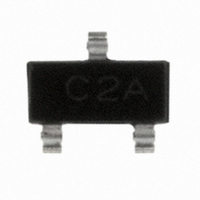HSMS-2822-TR1G Avago Technologies US Inc., HSMS-2822-TR1G Datasheet - Page 9

HSMS-2822-TR1G
Manufacturer Part Number
HSMS-2822-TR1G
Description
DIODE SCHOTTKY RF SER 15V SOT-23
Manufacturer
Avago Technologies US Inc.
Datasheet
1.HSMS-2823-BLKG.pdf
(15 pages)
Specifications of HSMS-2822-TR1G
Package / Case
SOT-23-3, TO-236-3, Micro3™, SSD3, SST3
Diode Type
Schottky - 1 Pair Series Connection
Voltage - Peak Reverse (max)
15V
Current - Max
1A
Capacitance @ Vr, F
1pF @ 0V, 1MHz
Resistance @ If, F
12 Ohm @ 5mA, 1MHz
Product
Schottky Diodes
Peak Reverse Voltage
15 V
Forward Continuous Current
1 A
Configuration
Dual Series
Forward Voltage Drop
0.5 V @ 0.01 A
Maximum Reverse Leakage Current
0.1 uA @ 1 V
Operating Temperature Range
+ 150 C
Mounting Style
SMD/SMT
Capacitance Ct
1pF
Diode Case Style
SOT-23
No. Of Pins
3
Breakdown Voltage
15V
Forward Voltage
340mV
Leaded Process Compatible
Yes
Rohs Compliant
Yes
Forward Current If Max
1A
Forward Voltage Vf Max
340mV
Lead Free Status / RoHS Status
Lead free / RoHS Compliant
Power Dissipation (max)
-
Lead Free Status / Rohs Status
Lead free / RoHS Compliant
Other names
516-1818-2
HSMS-2822-TR1G
HSMS-2822-TR1G
Available stocks
Company
Part Number
Manufacturer
Quantity
Price
Company:
Part Number:
HSMS-2822-TR1G
Manufacturer:
AVAGO
Quantity:
5 667
Company:
Part Number:
HSMS-2822-TR1G
Manufacturer:
AVAGO
Quantity:
2 000
Part Number:
HSMS-2822-TR1G
Manufacturer:
AVAGO/安华高
Quantity:
20 000
9
Sampling Applications
The six lead HSMS‑282P can be used in a sampling circuit,
as shown in Figure 25. As was the case with the six lead
HSMS‑282R in the mixer, the open bridge quad is closed
with traces on the circuit board. The quad was not closed
internally so that it could be used in other applications,
such as illustrated in Figure 17.
Figure 25. Sampling Circuit.
Thermal Considerations
The obvious advantage of the SOT‑323 and SOT‑363 over
the SOT‑23 and SOT‑142 is combination of smaller size
and extra leads. However, the copper leadframe in the
SOT‑3x3 has a thermal conductivity four times higher than
the Alloy 42 leadframe of the SOT‑23 and SOT‑143, which
enables the smaller packages to dissipate more power.
The maximum junction temperature for these three fami‑
lies of Schottky diodes is 150°C under all operating con‑
ditions. The following equation applies to the thermal
analysis of diodes:
Tj = (V
where
T
T
θ
V
P
sampling
pulse
sample
a
j
jc
RF
point
f
= junction temperature
I
= diode case temperature
= thermal resistance
f
= RF power dissipated
= DC power dissipated
f
I
f
+ P
RF
HSMS-282P
) θ
jc
+ T
a
sampling circuit
(1)
Note that θ
to the foot of the leads, is the sum of two component re‑
sistances,
Package thermal resistance for the SOT‑3x3 package is ap‑
proximately 100°C/W, and the chip thermal resistance for
the HSMS‑282x family of diodes is approximately 40°C/W.
The designer will have to add in the thermal resistance
from diode case to ambient — a poor choice of circuit
board material or heat sink design can make this number
very high.
Equation (1) would be straightforward to solve but for the
fact that diode forward voltage is a function of tempera‑
ture as well as forward current. The equation for V
where
n = ideality factor
T = temperature in °K
R
and I
I
I
Equation (4) is substituted into equation (3), and equa‑
tions (1) and (3) are solved simultaneously to obtain the
value of junction temperature for given values of diode
case temperature, DC power dissipation and RF power
dissipation.
I
I
s
s
f
f
s
= I
= I
= I
= I
= diode series resistance
θ
0
0
jc
S
S
S
(diode saturation current) is given by
(
(
= θ
e
e
298
298
T
T
pkg
11600 (V
11600 (V
jc
)
)
, the thermal resistance from diode junction
+ θ
n – 4060
n – 4060
2
2
chip
e
e
nT
nT
f
f
– I
– I
f
f
(
(
R
R
1
1
s
s
T
T
)
)
– 1
– 1
–
–
298
298
1
1
)
)
(2)
(3)
(4)
f
is:























